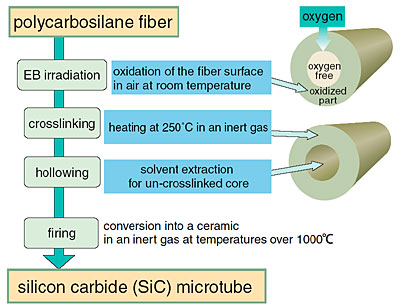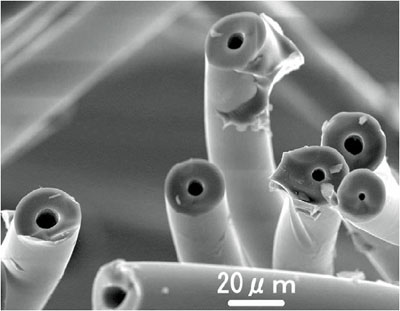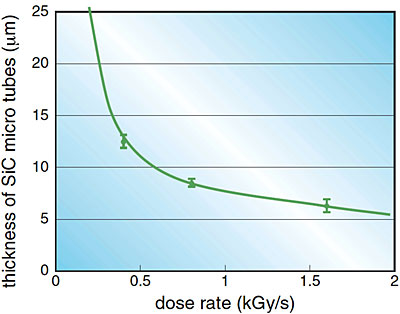Silicon carbide (SiC) fibers synthesized by pyrolysis from polycarbosilane (PCS) are long and flexible with excellent heat resistance, high strength, and low reactivity. This fiber has been suggested as a new reinforcement fiber for ceramic composite materials used in high-temperature gas turbines. The spinability of PCS is rather limited, and it would be difficult to make polymer tubes of PCS using the special spinning methods used to produce polyethylene fibers. We have found that a PCS fiber could be cured by EB oxidation of only the surface of the fiber. Subsequently, a fiber so cured can be hollowed out by removing the un-crosslinked core, thus forming a micro-tube.
Fig.6-3 shows the fabrication process of SiC micro tubes. When PCS fibers are irradiated in air, free radicals are produced uniformly and react preferably with oxygen. In the case of EB irradiation, if the dose rate is high enough compared with the rate of oxygen diffusion, oxidation takes place only at the surface of the PCS fiber. The oxidized part of the PCS fiber becomes crosslinked with oxygen by heating up to 250degree Celsius in an inert gas. We have succeeded in making PCS tubes by extracting the un-crosslinked core. In this process the crosslinked part is not affected by the solvent, but the un-crosslinked core is completely dissolved. The PCS tubes so created are converted to amorphous SiC tubes, as shown in Fig.6-4, by pyrolysis in an inert gas at temperatures over 1000degree Celsius. The thickness of the SiC micro tube can be controlled by the irradiation rate (dose rate), as shown in Fig. 6-5. In the case of a higher dose rate, the degree of oxidation at the tube surface increases with the rate of free radical production.
SiC micro tubes produced in this fashion have high corrosion resistance in addition to high strength and heat resistance. Therefore, such tubes can be applied to ceramic filter, adsorbent, catalyst, and micro-reactor at high temperatures and in corrosive environments. JAERI is currently conducting research that aims to boost the performance of thermochemical hydrogen production systems using nuclear heating. The associated hydrogen separation filters are a potential application for SiC micro tubes.
|


